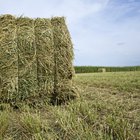
Thomas Jefferson failed at growing Vitis vinifera, the classic European wine grape, in the challenging climate of his native Virginia. The late 20th century, however, brought advances in viticulture—including new grafting technologies and improved trait selection—that helped the state overcome Nature's hurdles, according to Virginia Tech experts. Successful wine-grape growing in the state now comes down to careful planning and execution.
Choose a well-draining site that remains as warm as possible in the winter months. This is particularly important, Virginia Tech points out, in areas of the state away from the coastal maritime influence. Based on a soil analysis—available through the Virginia Cooperative Extension—organic or chemical amendments might be necessary.
Select a grape variety best suited for Virginia's growing conditions. According to the Virginia Vineyards Association, Chardonnay leads the state among white-grape varieties, while Cabernet Franc is the most-planted red variety. Washington Post wine writer Dave McIntyre proclaimed these two varieties from Virginia "can match the best in the world."
Prepare the site during the fall months. Jeff Cox, in his influential guide "From Vines to Wines," recommends digging a trench three feet wide and deep and refilling with the removed soil. Use a shovel or, for larger projects especially, considering renting a backhoe.
Erect trellising before planting your vines in order to ensure your young plants are not damaged in the process. An almost infinite number of trellising systems are available. The Virginia Cooperative Extension offers valuable insight and guidance on selecting and installing trellising.
Purchase grape vines. Don't feel compelled to purchase your vines locally. The Virginia Cooperative Extension maintains a list of nurseries on their website and points out that locally sold grape vines hold no particular advantage over those purchased from California or elsewhere. Bare-rooted grape vines are most common. They should be planted as soon as possible after they are received in order to prevent excessive drying.
Plant your vines in accord with the spacing you have set up with your trellising system. Follow the nursery instructions regarding soaking or trimming the vine root before planting. Jeff Cox recommends planting the vine to a depth that places that rootstock graft two to three inches above the soil surface. Although grape vines do not require a dedicated irrigation system in Virginia, watering at planting and in the first year will aid growth, as will water during dry periods until the vine is fully mature, at about four years.
Prune your vines in the first two years so the vine can establish strong roots, reach the trellis and gain stability. This requires trimming away all flower clusters that appear. At maturity, prune according to the trellising system you installed.
Pick your grapes at the desired level of ripeness, using a refractometer to determine sugar content and taste to assess flavor development. Consistently underripe grapes at the end of the growing season can be a sign of overcropping; address this problem by cluster thinning in the spring.
Related Articles

What Makes Strawberries Taste Sour?

Alfalfa Hay Nutrition Information

Maine Wild Edible Plants

Hydroponic Vegetable Nutrients Vs. ...

How to Remove Seeds From Concord Grapes

What Flowers Are in Season in November?

Are Pickled Vegetables Allowed on a Raw ...

Types of Amber Wine

Benefits of Lotus Stem

List of Wild Edible Plants & Berries in ...

What Kinds of Nuts Don't Grow on Trees?

The Meaning of Allium Flowers

The Effects of Organic Fertilizer on ...

Organic Vs. Conventional Olive Oil
When Is Grapefruit Season in Florida?

How to Plant a Tree in a National Park ...

Places to Pick Wild Blueberries in ...

Dill Seed Vs. Dill Weed

How to Grow an Oak Tree From an Acorn, ...

What Plant Do Caraway Seeds Come From?
References
Writer Bio
A writer and editor for more than two decades, Pete Danko has been widely published on topics ranging from finance to sports to wine and food. He has been an editor at Wine.com and been published in Wired News. He is a graduate of UC Berkeley, where he earned a Bachelor of Arts in economics.
Photo Credits
Vine - Field grape-vine image by Sebastien Icard from Fotolia.com